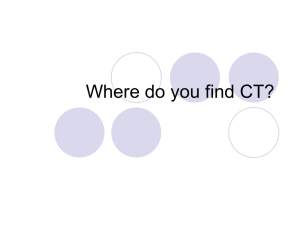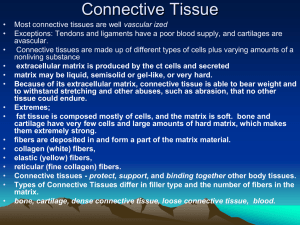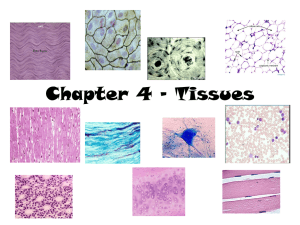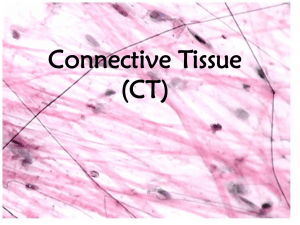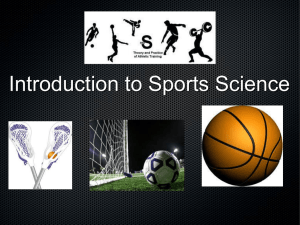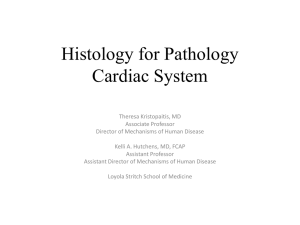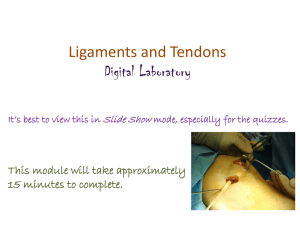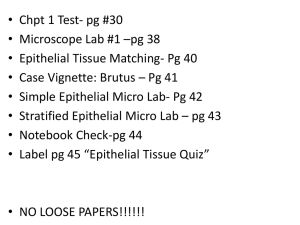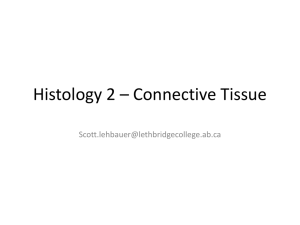Connective Tissue Cells - Mrs. Dearden`s Classes
advertisement
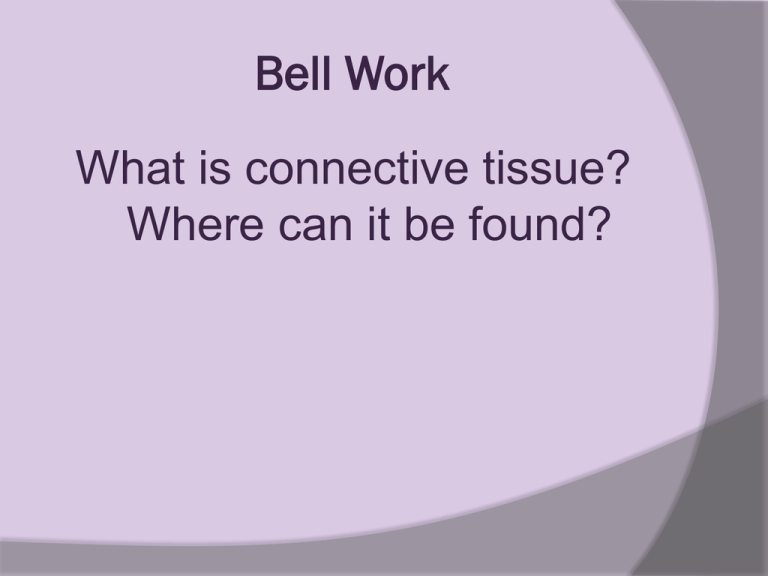
Bell Work What is connective tissue? Where can it be found? Connective Tissue Most diverse and abundant tissue Main classes: Connective tissue proper Cartilage Bone tissue Blood Connective Tissue- General Features Components of connective tissue: Cells (varies according to tissue) Extracellular Matrix (in btw. Cells) ○ Protein Fibers ○ Ground substance Other Characteristics: Not on body surfaces Highly vascular (except cartilage) Connective Tissue Cells 1. “Blast” Cells Immature class of cells- blast cells have ability to divide & secrete extracellular matrix Called: ○ Fibroblasts in loose & dense connective tissue ○ Chondroblasts in cartilage Once EC matrix is ○ Osteoblasts in bone produced, “blast” cells become “cyte” cells & maintain the matrix Connective Tissue Cells 2. Fibroblasts- found in most connective tissue,large/flat & branching; secrete fibers and EC matrix 3. Adipocytes- fat cells (deep to skin) 4. Mast cells- help in the body’s reaction to injury & infection (alongside blood vessels) Produce histamine which dilates vessels 5. WBCs- fight pathogen invasion & inflammation Macrophages- engulf bacteria Plasma Cells- develop from a WBC & they secrete antibodies (neutralize foreign substances) Connective Tissue Cells Extracellular Matrix Definition: material btw cells Functions: Supports cells/ binds cells together Stores water Provides a medium for exchange of substances btw. cells & blood Components: Fibers & Ground Substance ECM Fibers- strengthen & support connective tissue Collagen 1. strong & resist pulling forces Not stiff thus flexible Found in cartilage, tendons, ligaments & bone Elastic 2. Provides strength & stretching Found in skin, blood vessels & lungs Reticular 3. Primary support & strength tissue Thinner than collagen fibers; branching networks Covers many organs (spleen, liver, lymph nodes) Collagen Fibers Elastic Fibers Reticular Fibers Ground Substance- connective tissue btw. cells Characteristics: May be fluid, semifluid, gelatinous, or calcified Composed of Glycosaminoglycans (GAGs) Polysaccharides Attract water Lubricate/support Types: Chondroitin Sulfate- supports/adheres skin, cartilage, tendons, bone & blood vessels Hyaluronic Acid- slippery & binds cells together, lubricates joints, & maintains structure shape Do Now: What components make up extracellular matrix? Describe each component. Entrance Slip 1. 2. 3. Name three cells found in connective tissue? What type of fiber has characteristics of strength and flexibility? What is ground substance? Give a characteristic of it. Connective Tissue Proper Loose Connective Tissue- loosely intertwined fibers btw. cells Areolar Reticular Adipose Dense Connective Tissue- thicker, denser fibers btw. fewer cells Regular Irregular Elastic Areolar Connective Tissue Description Gel-like matrix w/: ○ 3 Fibers: collagen, reticular, & elastic for support ○ Ground substance is made up by many GAGs Cells – fibroblasts, macrophages, mast cells, white blood cells, adipocytes Function Wraps & cushions organs Binds the skin to underlying organs & fills space between muscles Important role in inflammation main battlefield in fight against infection Areolar Connective Tissue Location Widely distributed under epithelia (has many blood vessels so it nourishes epithelial cells) Packages organs Surrounds capillaries Adipose Tissue Description Closely packed adipocytes Nucleus pushed to one side by fat droplet Function Provides reserve food fuel Insulates against heat loss Supports & protects organs Location Found by areolar tissue Under skin- insulates the body & protects organs Cushions joints Around kidneys, between muscles, behind eyeballs, within abdomen and in breasts Reticular Connective Tissue Description – network of reticular fibers in loose ground substance Function – form a soft, internal skeleton (stroma- covers soft organs) Location – lymphoid organs Lymph nodes, bone marrow, and spleen Dense Regular Connective Tissue Description Parallel collagen fibers Fibroblasts and some elastic fibers Poorly vascularized Function Attaches muscle to bone Attaches bone to bone Withstands great stress in one direction Location Tendons and ligaments Fascia around muscles Dense Irregular Connective Tissue Description Irregularly arranged collagen fibers Some elastic fibers and fibroblasts Function Withstands tension Provides structural strength Location Dermis of skin Heart valves Surrounds cartilage & bone Submucosa of digestive tract Fibrous capsules of joints and organs Elastic Connective Tissue Description Branching elastic fibers Some fibroblasts Function Very elastic Can recoil to its original shape after being stretched Location Lung tissue Elastic arteries Vocal chords Ligament btw. vertebrae Connective Tissue Catch Phrase Set the timer. Give the stack of cards to someone on Team 1. One person from Team 1 will try to give their team mates clues to their phrase. If Team 1 guesses the phrase, Team 2 gets the stack of cards and tries to guess their phrase. Continue the game by going back and forth, as each team guesses the correct phrases. If the buzzer sounds during your turn, the other team gets a point and has the chance to earn a bonus point if they guess your phrase. Bell Work What are the three types of loose and dense connective tissue? Cartilage Characteristics: Firm, flexible tissue Contains no blood vessels or nerves Matrix contains up to 80% water Mainly collagen & elastic fibers Cell type – chondrocyte Types: Hyaline Fibrocartilage Elastic Hyaline Cartilage Description Collagen fibers not in the matrix (hyaline = glassy) Chodroblasts produce matrix Chondrocytes lie in lacunae (space in mature cartilage) Function Supports and reinforces Resilient cushion/ Resists repetitive stress Reduces friction Hyaline Cartilage Location Fetal skeleton Ends of long bones Costal cartilage of ribs Cartilages of nose tip, trachea, and larynx Joints *weakest of the 3 cartilages Fibrocartilage Description Matrix similar, but less firm than hyaline cartilage Thick collagen fibers predominate in matrix w/ scattered chondrocytes Function Tensile strength w/ ability to absorb compressive shock Location Intervertebral discs Pubic symphysis (where hips join) Discs of knee joint *strongest type of cartilage Elastic Cartilage Description More elastic fibers in matrix w/ chondrocytes Function Maintains shape of structure Allows great flexibility Location Supports external ear Epiglottis Bone Tissue Function Supports and protects organs Provides levers and attachment site for muscles Stores calcium and other minerals Stores fat Marrow is site for blood cell formation Characteristics ETC matrix= lamellae rings of mineral salts Lacunae- spaces in lamellae containing osteocytes Location Bones Blood Tissue Description red and white blood cells in a fluid matrix Function transport of respiratory gases, nutrients, and wastes Location within blood vessels Characteristics An atypical connective tissue Consists of cells surrounded by nonliving matrix (blood plasma- mainly water & dissolved nutrients) Do Now: What is the proper name of a bone cell, and what is the name of the space in which a bone cell lies? Do Now: What are the three types of dense connective tissue? Muscle Tissue Types Skeletal muscle tissue Cardiac muscle tissue Smooth muscle tissue Skeletal Muscle Tissue Characteristics Long, cylindrical cells Multinucleate Obvious striations Function Voluntary movement Manipulation of environment Facial expression Location Skeletal muscles attached to bones (occasionally to skin) Long, cylindrical cells that tend to have more than one nuclei. Cardiac Muscle Tissue Function Contracts to propel blood into circulatory system Characteristics Branching cells Uninucleate Intercalated discs Location Occurs in walls of heart Long, cylindrical cells that are shorter than skeletal muscle cells. They have only one nucleus per cell. Smooth Muscle Tissue Characteristics Spindle-shaped cells with central nuclei Arranged closely to form sheets No striations Function Propels substances along internal passageways Involuntary control Location Mostly walls of hollow organs These cells are tapered at the ends, giving them a spindle appearance. They have one nucleus and are not striated. Nervous Tissue Function Transmit electrical signals from sensory receptors to effectors Location Brain, spinal cord, and nerves Description Main components of brain, spinal cord, & nerves Contains two types of cells ○ Neurons – excitatory cells ○ Supporting cells (neuroglial cells) Neurons consist of the cell body, which does basic cell activities, and dendrites (which receive impulses) and axons (one per cell, conducting impulses away from cell body). Tissue Response to Injury Inflammatory response – non-specific, local response Limits damage to injury site Immune response – takes longer to develop and very specific Destroys particular microorganisms at site of infection The Tissues Throughout Life At the end of second month of development: Primary tissue types have appeared Major organs are in place Adulthood Only a few tissues regenerate Many tissues still retain populations of stem cells ○ Stem cells- divide/ differentiate into specialized cell types With increasing age: Epithelia thin Collagen decreases Bones, muscles, and nervous tissue begin to atrophy Poor nutrition and poor circulation – poor health of tissues Covering and Lining Membranes Combine epithelial tissues and connective tissues Cover broad areas within body Consist of epithelial sheet plus underlying connective tissue Three Types of Membranes Cutaneous membrane – skin Mucous membrane Lines hollow organs that open to surface of body An epithelial sheet underlain with layer of lamina propria Serous membrane – slippery membranes Simple squamous epithelium lying on areolar connective tissue Line closed cavities ○ Pleural, peritoneal, and pericardial cavities




